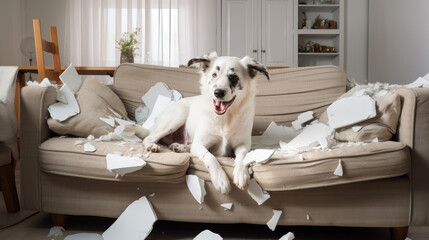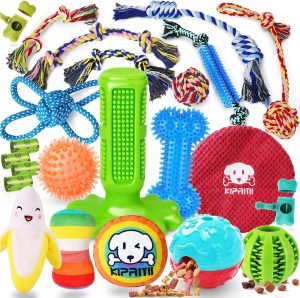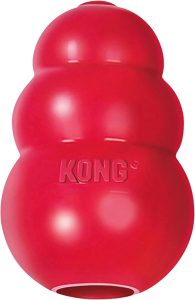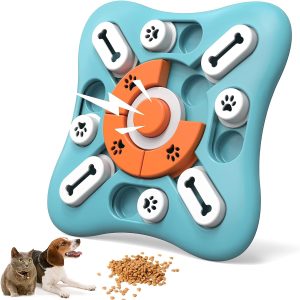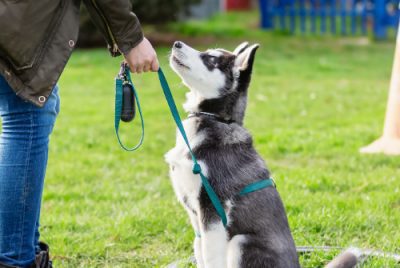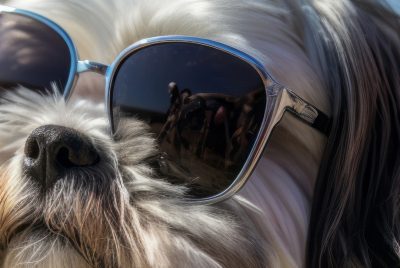Stop Dog Furniture Chewing: Effective Techniques
Post Disclaimer
We may earn a commission for purchases made using our links. Please see our Disclaimer to learn more.
Say Bye to Dog Furniture Chewing – Effective Techniques
Does your dog chew on furniture and you’re at your wit’s end? Don’t fret; we can help! Knowing why your dog chews, how to spot excessive chewing, and how to prevent it is essential. Let us guide you through identifying separation anxiety, picking the right chew toys, and optimal nutrition that can discourage furniture chewing. Lastly, we’ll assess the damage done to your furniture and whether fixing or buying new pieces is worthwhile. With these techniques, you can put a stop to destructive furniture chewing for good!
Understanding the Causes of Destructive Chewing in Dogs
Dogs chew for different reasons, including teething, loneliness, and boredom. This behavior is common in all dogs and can be a way of coping alone. Giving dogs appropriate toys, mental stimulation, and a safe space in their new home can redirect this destructive behavior.
The Role of Teething in Puppies

Teething puppies chew to ease gum pain and shed baby teeth. Give them chew toys for comfort and healthy habits. Edible chews are great because they satisfy natural chewing needs. This is a fun process for young dogs and helps with development.
Separation Anxiety and its Impact
To prevent dogs from chewing things they shouldn’t, consider crate training and taking them for daily walks. Playtime and mental stimulation can also help with separation anxiety. If you’re struggling to manage your dog’s behavior, seek advice from a veterinarian. You could also try dog sports or puzzle toys.
Boredom and Lack of Exercise
If your dog chews things a lot, it might be bored or need more mental stimulation. You can help by giving your dog regular exercise and playtime. It’s also important to use toys and do activities that are good for their age. Training and agility activities can help. Older dogs may need special chews to keep them mentally active too.
Identifying Signs of Excessive Chewing in Dogs
Excessive chewing of household items can harm dogs’ gums and may cause gagging or choking. It can also damage furniture and indicate underlying issues. Even adult dogs can display this behavior, so it is essential to identify and address the habit early on for their overall health.
Damage to Household Items
If your dog is chewing on household items, they may be bored or uncomfortable. You can prevent this by giving them toys to chew on. If that doesn’t work, try using lemon juice as a deterrent. It’s also important to give your dog appropriate things to chew on. If the problem continues, consult a vet.
Frequent Gagging or Choking
If dogs often gag or choke, they may have eaten something wrong. So, it’s important to watch them closely. Giving them chew toys can help stop this behavior. It’s also important to supervise them and teach them to play with safe toys so they don’t choke.
Techniques to Stop Your Dog from Chewing Furniture
To get dogs to stop chewing on furniture, train them to use dog toys instead. Give them a variety of toys they like so they can chew naturally. Use positive reinforcement and rewards to encourage good behavior. You can also give them puzzle toys to keep their minds busy and focused.
Training Your Dog to Use Chew Toys
Introducing suitable dog toys to young pups is important. This helps them chew on the right things, like toys, instead of household items such as shoes. Adding peanut butter or cream cheese can make the toys more appealing. Crate training will prevent inappropriate chewing when unsupervised.
The Importance of Consistent Training
Consistent training is vital to teach dogs good chewing habits. Establish a routine for playtime and chew activities. This helps them learn what items they can and cannot chew on. You must train them to differentiate between appropriate and inappropriate chew toys. Regular monitoring and redirecting towards the right chews is essential. Seeking guidance from professional dog trainers can also help you in consistent training. Positive reinforcement techniques like praising or rewarding your dog when they choose appropriate toys can reinforce good chewing habits. Keep in mind that different breeds, ages, and health conditions may require different types of training methods or toys. Consultation with a veterinarian or professional dog trainer can provide valuable insights into specific needs and behaviors. Providing your dog with plenty of exercise and mental stimulation can reduce destructive chewing behaviors caused by boredom or anxiety. Interactive toys like puzzle feeders or treat-dispensing balls can keep your dog occupied while promoting healthy chewing habits. Overall, proper guidance and consistent training are key to reinforcing good chewing behavior in dogs.
Using Deterrent Sprays
Discouraging dogs from chewing on furniture can be achieved using safe deterrent sprays. Natural options like lemon juice or apple cider vinegar are effective and protect furniture. Regular application of such sprays helps train dogs to avoid furniture chewing. Deterrent sprays serve as an excellent choice for preventing destructive chewing behaviors in young dogs and protecting household items.
Dealing with Your Dog’s Separation Anxiety
If you want your dog to stop destroying things, it’s important to deal with separation anxiety. The best way to handle it is through training, slow separation, and mental exercises. It’s also important to figure out why the anxiety is happening in the first place. Some things that can help are giving your dog toys, making a safe area for them, and sticking to a schedule. By doing this, your dog will behave better and not chew on things they shouldn’t.
Providing Mental Stimulation and Exercise
If you want to stop your dog from chewing on furniture, one way is to play interactive games. You can also engage your dog in sports. These activities will stimulate their mind and decrease destructive behavior. To prevent your dog from getting bored, it’s important to make time for daily walks and playtime. Dogs of all ages, including adult dogs and puppies, need mental and physical activity to stay healthy.
Creating a Safe Space for Your Dog
When you’re not around, create a small room or crate with dog toys for your pet. This will prevent destructive chewing and help your dog feel safe. Introduce the space gradually so that it becomes a positive environment for your dog’s mental well-being.
Choosing the Right Chew Toys for Your Dog
When choosing dog toys, think about your dog’s size and breed. Look for materials that are safe and natural. They should also be able to handle your dog’s strength while playing. Offering different types of chew toys like kong toys and puzzle toys can keep your dog entertained and mentally stimulated. Giving your dog the right things to chew may stop them from chewing on your old shoes or furniture.
Factors to Consider When Buying Chew Toys
When you pick a chew toy for your dog, think about their age, chewing habits, and likes. You must select toys made for teething puppies or adult dogs. Toys that dispense treats and those that you can play with stimulate the mind and bring enjoyment. They also help to soothe sore gums and promote good dental health. Getting chew toys of high quality is important if you want to stop harmful chewing. Think about these things when choosing toys for your dog’s mouth and health.
Safe and Unsafe Materials for Chew Toys
When you choose chew toys for your dog, focus on safety and avoid small pieces that can choke your pet. Look for strong and safe materials, such as rawhide and pig ears. Be careful of toys that could hurt the mouth or cause splinters. Pick toys that are both fun and safe for your furry friend to enjoy, making sure they have a great chewing time.
What to Do If Your Dog Continues Chewing Furniture
If your dog has a habit of persistently chewing furniture, it is essential to seek professional help from a certified dog trainer or veterinarian. Identifying the root cause of this behavior and employing behavior modification techniques can go a long way in resolving the issue. Providing safe chew toys and deterrent sprays can redirect your dog’s chewing habits. It is also important to monitor your dog’s behavior and seek guidance on efficient training methods. Additionally, ensuring that your dog gets enough physical and mental stimulation through exercise and playtime can help reduce destructive behaviors like furniture chewing. Remember, patience, consistency, and positive reinforcement are key when training a dog with behavioral problems.
Seeking Professional Help
If your dog chews things it shouldn’t, see a vet to check for health problems. A dog trainer can help you modify chewing behavior and manage anxiety. This can help you find effective solutions for your dog’s chewing habits.
Assessing Your Dog’s Overall Health
When taking care of your dog’s health, it’s important to visit the vet regularly for a full checkup. If your dog chews things destructively, it could be due to dental problems or other health issues. So, talk to your vet if you have any concerns. Keeping your pet fit and healthy will also help improve their chewing behavior and keep them happy overall.
Impact of Diet and Nutrition on Chewing Behavior
Nutrition is important for managing a dog’s chewing habits. A balanced diet can reduce destructive chewing, but nutritional deficiencies may lead to inappropriate chewing. Diet impacts mental stimulation and teething habits. Knowing how diet affects chewing can help address excessive chewing in dogs.
Nutritional Needs of Dogs Prone to Chewing
Dogs need enough protein for their muscles and health. Omega-3 fatty acids in food help with chewing and thinking. Vitamin E helps keep gums healthy, which is important for dogs that like to chew. Calcium and phosphorus make teeth strong, affecting how dogs chew. A good diet with the right nutrients can stop excessive chewing.
Foods That Help in Reducing Chewing
Dogs like to chew and it can damage our things. Carrots, apple slices, and frozen fruits can help them chew less destructively. High-fiber food can also make them feel full and reduce bad chewing habits. Giving dogs treats like bully sticks can also be a good idea. Natural dog food is another option for controlling their tendency to chew.
How to Repair Damaged Furniture
Assessing damage severity is crucial before repairing furniture. Determine the damage extent to decide whether to repair or replace furniture. Lemon juice can discourage chewing, while dog toys and appropriate items can prevent further damage. Seek professional help for extensive damages for effective furniture repairs.
Is Getting a New Furniture Worth It?
Investing in furniture that dogs cannot chew on can help decrease destructive chewing. If you give your dog the right chew toys and train them consistently, they will not need to ruin your furniture. It is essential to know how your dog chews before replacing furniture. By taking preventative steps, you can make your furniture last longer.
Conclusion
To prevent dogs from destructive chewing, you should understand its causes and use effective techniques. To redirect your dog’s chewing behavior towards chew toys, address issues like boredom, teething, and separation anxiety. Break the habit of furniture chewing by training your dog consistently and using deterrent sprays. Reducing chewing behavior can be achieved by providing mental stimulation, creating a safe space, and giving a balanced diet. If your dog continues to chew on furniture despite your efforts, seek professional help and assess their overall health. Consistency and patience are key in helping your furry friend overcome destructive chewing habits.

